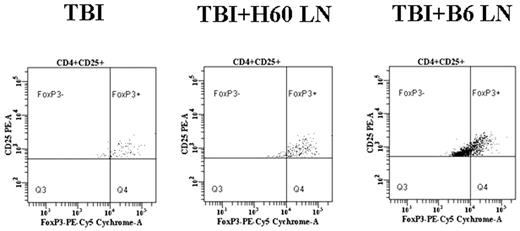Abstract
We have produced a murine model of immune-mediated bone marrow (BM) failure based on minor histocompatability antigen mismatch. Infusion of C57BL/6 (B6) lymph node (LN) cells into congenic C.B10 mice results 2–5 weeks later in severe marrow hypoplasia and fatal pancytopenia. Expansion of pathogenic T cells, especially cytotoxic T cells specific for the dominant minor antigen H60, is critical in disease progression: infusion of LN cells from H60-matched congenic B6 donors failed to induce BM failure in C.B10 recipients. We observed that the proportion of CD4+CD25+ T cells in the BM increased significantly in LN-cell-infused animals, coordinate with BM invasion by CD4 and CD8 T cells. However, a very large fraction (60–80%) of CD4+CD25+ T cells from BM failure mice did not express intracellular FoxP3, in contrast to CD4+CD25+ cells from normal BM which were 80–90% FoxP3+. In the mouse model, there were significant declines in the ratios between regulatory T cells and total T cells in the BM: CD4+CD25+FoxP3+ (Treg) to CD4+CD25+FoxP3− (activated CD4 cells) ratio decreased from 1 : 0.29 to 1 : 2.10; CD4+CD25+FoxP3+ to CD4+ ratio decreased from 1 : 7.01 to 1 : 19.87 whereas CD4+CD25+FoxP3+ to CD8+ ratio decreased from 1 : 7.94 to 1 : 46.71 when unaffected animals and BM failure mice were compared. Infusion of as few as 5000 CD4+CD25+ T cells obtained from normal B6 mouse spleen (>80% FoxP3+) with allogeneic B6 LN cells prevented H60-specific T cell expansion in C.B10 recipients and suppressed marrow destruction. A reduced regulatory T cell to activated T cell ratio accompanies pathogenic T cell expansion in this model of immune-mediated marrow destruction. Added regulatory T cells can suppress T cell expansion and prevent murine aplastic anemia. Our model concurs with recent observations in human aplastic anemia, in which numbers and activity of circulating regulatory T cells are much reduced in comparison to healthy controls (Solomou EE et al. ASH abstract submitted). Regulatory T cells might be useful in cellular therapy of autoimmune diseases.
Disclosure: No relevant conflicts of interest to declare.


This feature is available to Subscribers Only
Sign In or Create an Account Close Modal